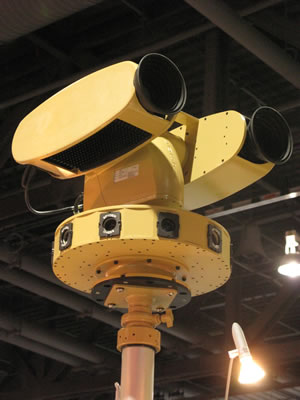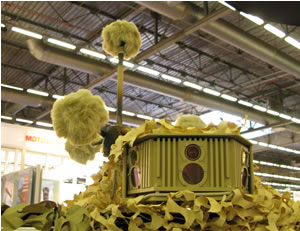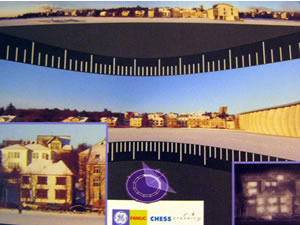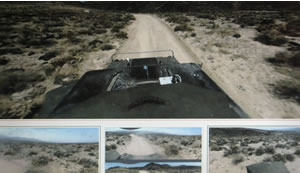When operating enclosed in armored vehicular platforms, such systems provide essential situational display in a conveniently ‘see through armor’ functionality.
One of the pioneers in this field is the Israeli company Elbit Systems, which displayed at AUSA 2008 an integrated family of products supporting combat from enclosed armored vehicles, encompassing sensors, distributed displays, integrated mounted and dismounted warfighter connectivity, vehicular mounted remotely operated weapon stations and autonomous platforms, all contributing to a common operating picture, supporting the operational and tactical unit level.
A different approach was presented by the Sarnoff Corporation, developing the ‘Combat Vehicle Vision’ approach, harnessing C4ISR technology, enabling real-time situational awareness, understanding and response. Sarnoff’s systems incorporate advanced day/night imaging sensors, video processing and image fusion, to improve threat detection. The system is designed in two versions for open and closed vehicle configuration. The open vehicle model is designed for tactical vehicles such as the HMMWV or MRAP, where relatively large windows allow the crew to monitor the surrounding area.
Sarnoff’s Computer Vision Assisted Combat Capability (CVAC2) system provides day/night visibility, automatic video threat detection and alerts and high resolution imaging and reconnaissance. The system can also be integrated with the Boomerang acoustic gunshot detector, to support real time information sharing, integration and control of aimable sensors, weapon systems. Providing a 360 degree situational awareness and understanding, a mast-mounted CVAC2 sensor pack includes a thermal LWIR) imager, day-night zoom camera mounted on a pan-tilt platform. CVAC2 can also be utilized in a tripod-mounted configuration, to protect installations, or in support of dismounted operations. The display combines panoramic, fused video display, fed by multiple imaging sensors, superimposed with cues from acoustic gunshot detection and motion or loitering sensors and geo-registered operational and intelligence annotations. The company also offers a Fused Vision System for the driver, enhancing visibility by combining images from Long Wavelength infrared (LWIR) and visible video imagery in real time to improve the drivers’ all-weather, day and night visibility. Automatic video enhancement processed on the image in real time contributes to extend the sensors’ dynamic range and depth of field.
Systems employed in a closed vehicle environment, rely on Distributed Aperture System (DAS) to deliver advanced vision capability, situational awareness. The system provides 360 deg. ‘see through’ turret, supporting separate displays for the driver, commander and crew members, empowering operators to benefit from some of the system’s sophisticated features. These include moving target indicators (MTI), estimation of threats, each reported with range and other threat attacks. The system employs integral data recorder for rapid retrieval of recorded segments.
Omniscape from DRS
DRS displayed a range of enhancements for its vehicular EO systems, including the well established Drivers Vision Enhancer (DVE), offered with improved situational awareness, facilitating safe driving under all lighting conditions. Based on an uncooled FLIR, this viewer enables the driver to spot potential obstacles, as well as IEDs and various ambush situations well in advance, during day and night. Added to create panoramic situational picture of the area surrounding the vehicle, additional thermal cameras operating at wide angles were also displayed on the DRS’s vehicle. The five cameras (a pair for each side and a rear camera) were feeding video streams to the Omniscape video and data multiplexing distribution system, capable of handling up to 21 standard video feeds and four output display formats. Each soldier can monitor the display configured with four windows, explore a single feed with superimposed vehicle data or view two images in a ‘picture in picture’ style.
 WideEye II: (FLIR Systems Vehicle Vision Systems VVES-FADS)
WideEye II: (FLIR Systems Vehicle Vision Systems VVES-FADS)
WideEye II ultra-wide field of view vehicle camera offers continuous security coverage superior to pan/tilt configurations. Two WideEye II cameras provide 360 degrees viewing, covering the vehicle’s entire perimeter. Its broad scene coverage can be used to cue a long range sensor, such as the weapon station’s optronic payload, to areas where motion is detected. According to the manufacturer, the system detects human intruders and threats at a distance of 500 meters, in daylight and in total darkness, through fog, smoke and most obscurants. The unit connects to the video monitoring system through standard Ethernet cabling.
Miniature Stabilized Sight (MSS)
Carl Zeiss introduced the Miniature Stabilized Sight (MSS) designed for installation on armored vehicles, particularly for close combat observation in urban terrain, or in asymmetric warfare scenarios. The camera’s pointing ability improves coverage under challenging situations, including very high elevations (urban canyons) or deployment in defilade positions, where static cameras (typically having 45 degrees in elevation) do not provide effective coverage. Typically four cameras will provide full panoramic coverage of the vehicle, operating when stationary or on the move. These sensors are providing autonomous situational awareness and can be enhanced with automatic tracking capability, to aid tracking of potential threats or targets, while on the move. Each MSS weighs about 5 kg, and can fit a combination of two sensors including daylight TV, uncooled thermal imager and laser rangefinder. 
Spyder Nano from GE Fanuc
GE Fanuc introduced the vehicle-mounted ‘Spyder nano’, mast mounted passive situational awareness and surveillance system, comprising video/IR camera and ten fixed imagers, either daylight TV or uncooled IR (or both), providing full 360 degree coverage in addition to the main surveillance sensor equipped with x36 zoom. The system is controlled from a mounted or field portable console, utilizing an innovative and intuitive user interface providing integral panoramic and narrow-field of view displays.
 OmniAlert360 from Remote Reality
OmniAlert360 from Remote Reality
Remote Reality Corp. returned to AUSA, this time, as part of the Raytheon display. According to company officials, the two companies are cooperating in areas, such as image tracking, correlation between targets spotted on the panoramic view, relaying them to other sensors and systems. Providing better interpretation of a situational picture at close range. Remote Reality displayed new optics utilized with the 360 degree camera, that support sensors either in the visible or IR range. Tested as part of the FCS program the continuous 360 degree camera proved to be superior to products produced by ‘stitched images’, primarily during dynamic high speed off-road travel.
















